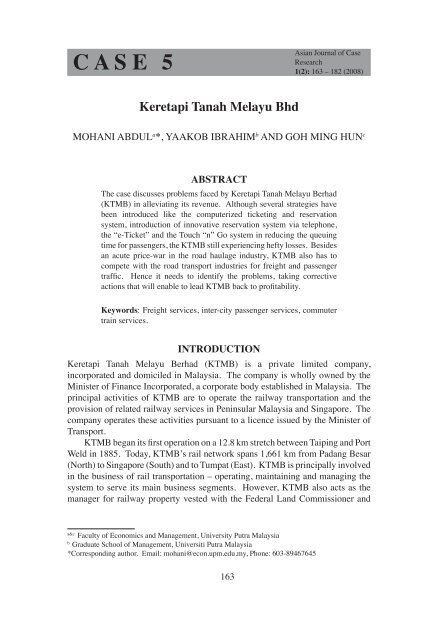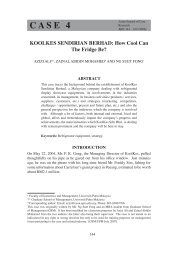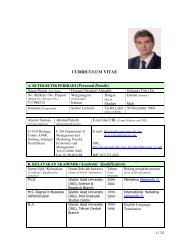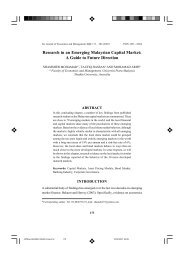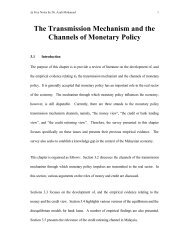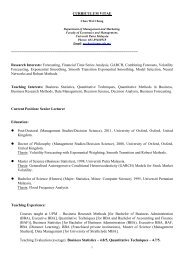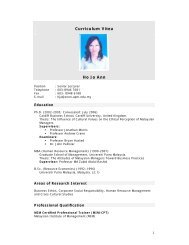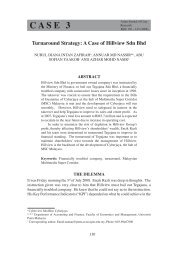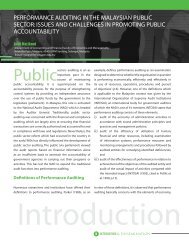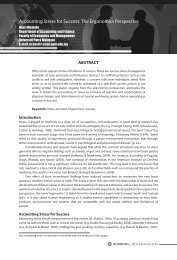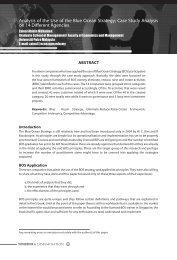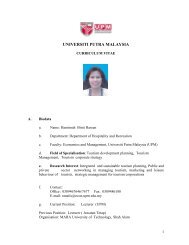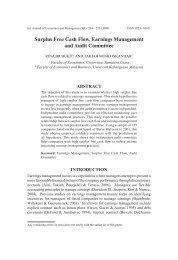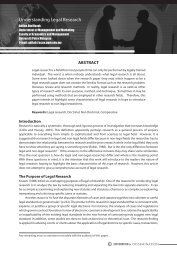Case 5 Mohani Abdul.pdf - Universiti Putra Malaysia
Case 5 Mohani Abdul.pdf - Universiti Putra Malaysia
Case 5 Mohani Abdul.pdf - Universiti Putra Malaysia
Create successful ePaper yourself
Turn your PDF publications into a flip-book with our unique Google optimized e-Paper software.
Asian Journal of <strong>Case</strong> Research (AJCR)compete with the road transport along the North-South Highway also lead toour losses. The Intercity Passenger Train Services recorded a decrease of 5.28%in revenue to RM68.35 million as compared with preceding year correspondingperiod revenue.”En. Mohd. Salleh, murmurred to himself, “I’ve been wondering if it is a goodmove for KTMB to continue with its programme of refurbishing the third classcoaches that ply to the East Coast.” Then the programme to construct electrifiedtracks between Ipoh and Rawang, linking the 2 major urban centres of Peninsular<strong>Malaysia</strong>, i.e - Kuala Lumpur and Ipoh, struck his mind. Electrified train serviceswould be operated between these 2 cities at better frequency and higher speeds.Travelling time is expected to be reduced to 2 hours based on a route speed of 160kmph. The new travel times and frequencies would make rail travel between KualaLumpur and Ipoh more economical, viable and practical. However, he wonderedwhether KTMB would be able to compete in the transportation market.En. Azman said confidently, “KTMB will continue its effort to turn railtravel as a preferred mode of public transportation. With the completion of theRawang-Ipoh Double Tracking Project, further improvement would be made onthe quality of services in terms of speed and reduced the travel time with smoothand comfortable journey. The provision of public amenities such as lengtheningof platforms, facilities for the disabled, additional seating facilities at stationsand directional signage will be our priority”. The passenger traffic statistics ofKTMB are shown in Appendix A.In facing the challenging circumstances, some measures have beenimplemented to enhance its operational efficiency and quality of customer service.Among the efforts that had been made were the improvements in the computerizedticketing and reservation system and the introduction of innovative reservationsystem via telephone, e-mail and website which is known as “e-Ticket”. The“e-Ticket” is an alternative method of purchasing train tickets via Internet,especially popular among tourists and students.Another important development of Intercity Passenger Services was theopening of the Sentral Station in Kuala Lumpur on 16 April 2001. The SentralStation is equipped with modern facilities and it is an integrated transportation hubin the city where the Express Rail links trains to KL International Airport (ERL),STAR Light Rail Transit, <strong>Putra</strong> Light Transit, KL Monorail, KTMB CommuterServices and KTMB Intercity Passenger Services Converge.The “Visit <strong>Malaysia</strong> Rail Pass” was relaunched in September 2002, toattract foreign tourists to travel by rail during their vacation in <strong>Malaysia</strong>. Severalpromotional activities were carried out throughout the country. Joint promotionsand strategic alliance with the players in the tourism industry such as touragencies and hotels were also held to promote rail services for travel to varioustourist destinations. One such joint venture was launched in September 2002between KTMB and Impiana Hotel, which operates a chain of hotels in <strong>Malaysia</strong>166
Keretapi Tanah Melayu Bhdthe Group turnover declined from RM382 million in 2001 to RM364 millionin 2002”. He also added that the operating revenue was expected to decreaselargely due to the loss from freight services during the construction period ofthe Rawang-Ipoh Double Tracking Project. Losses from railway operations wereexpected to increase mainly due to the reestablishment of deferred maintenanceof rolling stock and railway infrastructure. KTMB was facing funding shortfallas a result of deferred operating expenditure in addition to loan repayments andcapital expenditure. En. Azman Shaharbi also explained that KTMB remainedseverely undercapitalized and over-leveraged. Revenue was recognized whenit was probable that the economic benefits associated with the transaction wouldflow to the enterprise and the amount of the revenue could be measured reliably.Table 2 depicts the revenues for the financial years 1998 up to 2002 forIntercity Passenger Services, Freight Services, Property and Commuter TrainServices; while Table 3 depicts the volume of freight handled by KTMB for thesefinancial years.Table 2 Revenue Analysis by Strategic Business Units (RM Million)Financial Year Intercity Freight Property Commuter2002 68.36 97.16 31.5 49.762001 72.16 101.9 30.41 45.682000 75.34 94.76 42.2 39.451999 78.2 75.15 28.36 38.911998 83.21 71.83 32.38 41.61Source: KTMB Annual Report Year 2002.Table 3 Volume of Freight Handled by KTMB (Million tonne)Financial YearVolume of Freight2002 3.82001 4.152000 5.481999 4.491998 4.35Source: KTMB Annual Report Year 2002.En. Mohd. Salleh further questioned, “Why did the Group’s turnover declinefrom RM382 million in 2001 to RM364 million in 2002?” He was a bit surprisedwhen he saw the accounts which were handed by En. Azman Shaharbi (Revenueat the Group and the Company level is shown in Table 4).169
Keretapi Tanah Melayu BhdTable 13 Intercity Passenger Fare Rates for the Year 2003ClassFare Rates (RM per km)1 st Class 0.15002 nd Class 0.06503 rd or Economy Class 0.0369SUPPLEMENTARY CHARGES FOR INTERCITY PASSENGER SERVICESSupplementary ChargeRM per PaxLower berth 1 st Class Air-conditioned 30.00Upper berth 1 st Class Air-conditioned 20.00Lower berth 2 nd Class Air-conditioned 14.00Upper berth 2 nd Class Air-conditioned 11.50Express Seater 4.00Air-conditioned coach 4.00Source: KTMB 2002.COMPETITION WITH INTER-CITY PASSENGER SERVICESComparison between Rail and Road NetworkThe investment in transport has provided Peninsular <strong>Malaysia</strong> with a diversifiedand extensive transport system in which the road network is most important.Because of the location pattern of economic activity and population, much of thetransport infrastructure, including the KTMB network is located on the west coastof Peninsular <strong>Malaysia</strong>. The alignment of transport infrastructure means thatKTMB has to compete with the road transport industries for freight and passengertraffic.As commented by En Azman Shaharbi during the meeting, the road transportindustries are the most pervasive source of competition to the services of KTMB.Further, train speeds on the KTMB network are low. Journey and haulage times onthe KTMB thus compared unfavourably with those of road transport. As reasonedby him, this could be due to some problems. Firstly, KTMB was essentially asingle-tracked system which resulted in frequent line blocks and secondly, thetechnical limitations on train speed on account of track alignment on the nonelectrificationof the rail network. Shortages of resources such as locomotivesand crews were also contributory factors for the low average train speeds. Theconstraints of narrow 1 meter track gauge (width of railway track is 1 meter)and old rolling stock limited the route speed for freight services. However, incomparison to the road network, the market coverage for the KTMB network175
Asian Journal of <strong>Case</strong> Research (AJCR)was restricted and from technical perspectives such as train speed, KTMB had itsshortcomings as compared to road transport. In the meantime, KTMB also hadsome advantages over the road transport industries in terms of the socio-economicbenefits such as the number of road accidents and pollution.Table 14 summarizes the Road and Rail Network Statistics in Peninsular<strong>Malaysia</strong> for the year 2000.Table 14 Table of Rail and Road Network of Peninsular <strong>Malaysia</strong> for the Year 2000Size of NetworkRoad – Total Road Network – 49,137 kmMotorcars 3,705,888Motorcycles 4,985,149Taxis 59,196Buses 40,358Goods Vehicles 536,189Other Vehicles 248,622Rail - Total railway network – 1700 kmLocomotives 64Freight Wagons 3,549Passenger Cars 208Source: KTMB 2002.Road NetworkIn the past decade, the road network had expanded by 8,100 km, from just over41,000 km in 1990 to slightly more than 49,000 km in 2000. The most importantcomponent of the country’s road system is the 864 km 2/3 lane North-SouthExpressway (NSE), which stretches from Bukit Kayu Hitam on the Thai borderto Johore Bahru in the South.All the major economic centres are linked to one another and to the ports bya network of good roads. The rural and outlying areas are also connected to themain inter-urban road grid. The federal and state roads in the country togetherwith the privatized roads thus constitute an extensive and nation-wide road systemfor Peninsular <strong>Malaysia</strong>.The average speeds on the roads are quite high due to the double-carriagewayand triple-carriage-way roads. Maximum permissible speed for motorcarsare between 90 to 120 kilometres per hour; whilst for buses and trucks, thecorresponding range is 80 to 90 kilometres per hour.176
Keretapi Tanah Melayu BhdWith growing affluence and booming local automobile industry, theautomobile population in Kuala Lumpur has increased very rapidly over recentyears. The significant increase in vehicle ownership coupled with decliningpublic transport usage has resulted in an inefficient and ineffective utilization ofroad space in the city. The situation is further aggravated by the fact that manyof the roads and intersections built in the city during the earlier days were notwell planned and too narrow to accommodate the increasing volume of traffic,resulting in severe traffic congestion during peak hours.The overall total vehicles using highways under <strong>Malaysia</strong>n HighwayAuthority’s (MHA) supervision until December 2001 increased from 640 millionvehicles to 700 million vehicles. The growth percentage of the total vehiclestravelling along the expressway tolls in 2001 as compared to the year 2000 was9%. This shows that there was an increase in the growth percentage of vehiclesbetween year 2000 to year 1999 by 17%. The increasing number of vehicle usagein <strong>Malaysia</strong> also contributed to the increasing number of road accidents, especiallyduring festive seasons. As in 2002, total road accidents occurred were 279,641with 5,886 deaths compared to 1996 with 189,109 road accidents.Rail NetworkThe rail network in Peninsular <strong>Malaysia</strong> is about 1,700 km in length. KTMB’strack infrastructure is a narrow-gauge system. As presented by En. Mohd. Sallehin the last meeting, being only 3% the size of the road system, the market outreachof KTMB in comparison to road transport, is very small. The main segment of theKTMB network is the 785 km west coast line from Butterworth to Tanjung Pagarin Singapore. KTMB network links 4 of the 5 principal ports with their respectivehinterlands, the only exception being Kuantan Port.Other Passenger Road TransportsThere are 67 bus companies operating and offering inter-city and urban passengerservices to almost all destinations throughout Peninsular <strong>Malaysia</strong>. The followingare examples of bus companies providing passenger services in Peninsular<strong>Malaysia</strong>:i.ii.iii.iv.Park May Berhad – North / South destinations.Plusliner & NiCE – Luxury express bus service.Ekspres Nasional Berhad – All destinations.Foh Hup Omnibus – North destinations, etc.177
Asian Journal of <strong>Case</strong> Research (AJCR)There were 6 taxi companies, which are in operation serving the North, South,East Coast of Peninsular <strong>Malaysia</strong> and Genting Highlands as their destinations forpassenger services. The following are some examples of taxi companies, whichare in operation:i.ii.iii.Persatuan Pemandu Teksi Bahagian Utara – Serves NorthdestinationsPersatuan pemandu Teksi Selatan – Serves SouthdestinationsPersatuan Pemandu Teksi Pantai Timur – Serves East Coastdestinations, etc.EXAMPLES OF TICKETING PRICES FOR INTERCITYPASSENGER SERVICES AND EXPRESS BUS TICKETSAs requested by En. Mohd. Salleh in their last meeting, En. Azman Shaharbipresented some ticketing prices for express bus compared to ticketing prices forintercity passenger services to the Board of Directors (Appendix B).En. Zakaria, the Head of <strong>Malaysia</strong>n Centre for Transport Studies (Mactrans)commented, “I think we should focus our strategy to the targeted customers andtailor our strategy to match with their needs and expectations.” “We have to dosomething, otherwise we are going to lose the battle.” En. Mohd. Salleh pausedand looked straight into En. Azman’s face. “Azman, do you have any idea how toattract more people to use our service?” “Definitely we have to offer better servicefor their money. We have to provide quality service, but …... unfortunately, wedo not have enough employees. The number of employees in the Group was only5073 at the end of financial year 2002 and 5053 for the Company.” En. Azmanreplied“We have done our best in equipping our officers and staff.” En. Mohd. Sallehrecalled. “Several in-house training programmes, seminars and workshops havebeen conducted throughout the year in ensuring our officers and staff are keptabreast of the latest information, knowledge and developments in rail operations,business management and customer service. With regards to total number ofemployees …..” En. Mohd. Salleh paused and continued, “How are we going tohire more employees with the current financial situation?”ACTIONS TO BE TAKENOn Monday 6 January 2003, at 4.00 pm, the Board of Directors and the SeniorManagement Team of KTMB were almost at the end of the Yearly Planning andManagement Meeting for the new Financial Year 2003, when En. Mohd Sallehsaid in closing of the meeting, “We are now at the crossroads where we have to178
Keretapi Tanah Melayu Bhdmake serious decisions as to which path to take in order to bring KTMB backto profitability. We have gone through in detail KTMB’s financial standingand operations matters and the transportation industry today and we all knowwhere KTMB stands financially today. And KTMB financial future does not lookgood.”En. Zakaria said, “Rapid and efficient service is an important criterion forany public transportation system, particularly rail service. With a good roadsystem, cars and buses tend to travel faster than trains. If KTMB wants to reduceits losses, it has to offer better and efficient service, including faster travel time.”At this point, the Chairman, Y.Bhg. Tan Sri Dato’ Thong Yaw Hong said,“It is now early January 2003, I have been analyzing the financial reports as awhole and I am very concerned on the hefty losses. The problems could be moresevere and complex than what Zakaria thinks that only by offering better service,including faster travel time, can KTMB improve its performance.” He then lookedat En. Mohd. Salleh and said, “I want you to resolve this problem by identifyingthe issues and then sourcing for a comprehensive and integrated solution to leadKTMB back to profitability.”179
Asian Journal of <strong>Case</strong> Research (AJCR)APPENDIX AKTMB – INTERCITY PASSENGER STATISTICS FOR THE YEAR 1980 – 2002.Passenger JourneysYear1st. Class 2nd Class 3rd. Class Total1980 43,212 1,042,989 5,980,962 7,067,1631981 43,085 1,080,680 6,232,040 7,355,8051982 38,699 1,178,205 5,899,951 7,116,8551983 38,387 1,177,703 5,425,546 6,641,6361984 48,531 1,552,007 5,033,225 6,633,7631985 73,544 1,705,904 4,576,554 6,356,0021986 86,747 1,876,076 4,772,412 6,735,2351987 89,882 1,764,243 4,717,107 6,571,2321988 111,894 1,925,967 5,246,795 7,284,6561989 121,249 1,435,246 6,997,175 8,553,6701990 137,061 1,211,918 6,670,371 8,019,3501991 143,277 1,230,410 6,649,410 8,023,0971992 178,879 1,650,168 5,785,447 7,614,4941993 162,802 2,100,563 4,246,762 6,510,1271994 123,864 1,785,362 3,516,695 5,425,9211995 112,722 1,776,903 3,256,329 5,145,9541996 130,135 2,000,074 3,722,080 5,852,2891997 133,326 1,905,138 3,337,135 5,375,5991998 111,835 1,962,183 2,849,787 4,923,8051999 96,976 1,607,709 2,639,717 4,344,4022000 91,414 1,564,528 2,145,151 3,801,0932001 89,937 1,466,865 1,953,197 3,510,0002002 88,241 1,468,162 1,880,718 3,437,121Source: KTMB 2002.180
Keretapi Tanah Melayu BhdAPPENDIX BTRANSPORTATION VIA TRAINTicketing Prices for Ekspres Langkawi from Kuala Lumpur to Alor Setar.BerthSeatCoach TypeUpper (RM) Lower (RM) Windows (RM) Aisle (RM)Adult Child Adult Child Adult Child Adult ChildADNFB (Premier Night Standard) 89.00 54.00 97.00 62.00 - - - -ADNS (Superior Night) 43.00 28.00 48.00 33.00 - - - -AEC (Economy) - - - - 20.00 11.00 20.00 11.00ASC (Superior) - - - - 35.00 20.00 35.00 20.00OriginDestinationTrain Name: TUMPAT: SENTRAL KUALA LUMPUR: EKSPRES WAUBerthSeatCoach TypeUpper (RM) Lower (RM) Windows (RM) Aisle (RM)Adult Child Adult Child Adult Child Adult ChildADNFB (Premier Night Standard) 98.00 58.00 106.00 66.00 - - - -ADNS (Superior Night) 47.00 30.00 52.00 35.00 - - - -AEC (Economy) - - - - 29.00 16.00 29.00 16.00AFC (Premier) - - - - 84.00 44.00 84.00 44.00ASC (Superior) - - - - 39.00 22.00 39.00 22.00181
Asian Journal of <strong>Case</strong> Research (AJCR)Ticketing Prices for Some Intercity Trains from Central Kuala Lumpur to Johor Bahru.Train NameEKSPRES SENANDUNG MALAMBerthSeatCoach TypeUpper (RM) Lower (RM) Windows (RM) Aisle (RM)Adult Child Adult Child Adult Child Adult ChildADNFD (Premier Night Deluxe) 106 78.00 126.00 98.00 - - - -ADNS (Superior Night) 37.00 25.00 42.00 30.00 - - - -AEC (Economy) - - - - 18.00 11.00 18.00 11.00ASC (Superior) - - - - 29.00 17.00 29.00 17.00EPLUS (Economy PLUS) - - - - 20.00 13.00 20.00 13.00EKSPRES RAKYATAFC (Premier) - - - - 64.00 36.00 64.00 36.00ASC (Superior) - - - - 33.00 21.00 33.00 21.00EPLUS (Economy PLUS) - - - - 22.00 15.00 22.00 15.00EKSPRES WAUADNFB (Premier Night Deluxe) 95.00 57.00 103.00 65.00 - - - -ADNS (Superior Night) 46.00 29.00 51.00 34.00 - - - -AEC (Economy) - - - - 28.00 15.00 28.00 15.00AFC (Superior) - - - - 81.00 43.00 81.00 43.00ASC (Superior) - - - - 38.00 21.00 38.00 21.00APPENDIX CTRANSPORTATION VIA BUSThe Fare for One – Way Trip from Kuala Lumpur to Some Major Cities by Some Express Buses.Bus Company Destination Adult (RM) Child (RM)Damai Ekspres Sdn BhdJohor BahruKota BahruAlor Setar24.0034.0030.0024.0034.0030.00Selat Keris Sdn BhdJohor BahruKota BahruAlor Setar24.0034.0030.0024.0034.0030.00TransnasionalJohor BahruKota BahruAlor Setar24.0030.9030.1012.0015.4515.05182


